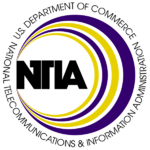National Telecommunications and Information Administration
The National Telecommunications and Information Administration (NTIA) is an agency for the United States Department of Commerce (DOC) that acts as the Executive Branch, responsible for recommending the United States President on various telecommunications and information policies. NTIA was formed in 1978 with an aim to work with other Executive Branch Agencies on crucial issues regarding telecommunications and information policies and also to report the administration’s current role and position in this policies and issues.
 | |
| Founded: | 1978 |
| Headquarters: | Herbert C. Hoover Building 1401 Constitution Avenue NW, Washington, D.C. |
| Country: | USA |
| Website: | ntia.doc.gov |
| Twitter: | |
NTIA has been always at the forefront of critical issues and has played an important role in providing the guidelines to create and execute new policies to address these issues. It also represents the Executive Branch of the government in national and international telecommunications and information policy activities. NTIA oversees Federal use of spectrum, it does research on various telecommunications and engineering related fields. It also manages the resolution of issues between the government and the private sector related to telecommunications and also provides grants to infrastructure and public telecommunications facilities.[1]
Goals
NTIA has many goals for the development of Telecommunication and information sector. The following are a few goals of NTIA:
- To provide U.S. citizens with internet, phone and cable services at an affordable rate.
- To provide information infrastructure grants for the development of under-served areas within the country.
- Providing scope for international competition in the telecommunications sector.
- To promote the adequate distribution of spectrum to various fields such as national defense, public safety, and businesses according to their demands and needs.
- Providing the infrastructure for the radio and television broadcasters to efficiently maintain and expand their services.
- Negotiating with other governments across the globe to provide platform for the U.S. companies to have a global outreach and provide their services internationally.
- To perform a long term research to find the new possibilities in using the higher frequency spectrum for telecommunication.
- Partnering with national, state and local public safety agencies to understand the necessities of the future spectrum on the grass root level. [2][3]
Organizational offices of NTIA
- Office of the Policy Analysis and Development (OPAD): OPAD looks after various domestic policies and is responsible for advising the Executive Branch on various issues and policies after performing adequate research and analysis. [4]
- Office of International Affairs (OIA): It is responsible for creating policies which will make the U.S. companies to compete internationally in both the fields of Information Technology and Communications. [5]
- Institute for Telecommunication Sciences (ITS): It is the research and engineering laboratory of the NTIA. ITS provides technical assistance in the field of Information Technology and Telecommunications to develop and implement various updated technologies in the field. It assists NTIA in the development of infrastructure for telecommunications and Information Technology to provide efficient services across the corners of the country. [6]
- Office of Telecommunications and Information Application (OTIA): It provides a platform for the public and Non-profit organizations to collaborate and work on various telecommunications and information technologies for the benefit of the national development and prosperity. [7]
- Office of Spectrum Management: It is responsible for supervising the use of spectrum provided to the Federal Government. It is also the part of the Department of Commerce (DOC) which oversees ICANN. [8]
References
- ↑ NTIA About
- ↑ facebook.comNational Telecommunications and Information Administration
- ↑ ecommerce.hostip.info
- ↑ OPAD Home
- ↑ ntia.doc.govOIA Home
- ↑ its.bldrdoc.gov
- ↑ ntia.doc.govOTIA Home
- ↑ ntia.doc.govOSM Home
